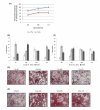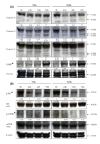Selenium enrichment of broccoli sprout extract increases chemosensitivity and apoptosis of LNCaP prostate cancer cells
- PMID: 19943972
- PMCID: PMC2794877
- DOI: 10.1186/1471-2407-9-414
Selenium enrichment of broccoli sprout extract increases chemosensitivity and apoptosis of LNCaP prostate cancer cells
Abstract
Background: Broccoli is a Brassica vegetable that is believed to possess chemopreventive properties. Selenium also shows promise as an anticancer agent. Thus, selenium enrichment of broccoli has the potential to enhance the anticancer properties of broccoli sprouts.
Method: Selenium-enriched broccoli sprouts were prepared using a sodium selenite solution. Their anticancer properties were evaluated in human prostate cancer cell lines and compared with those of a control broccoli sprout extract.
Results: Selenium-enriched broccoli sprouts were superior to normal broccoli sprouts in inhibiting cell proliferation, decreasing prostate-specific antigen secretion, and inducing apoptosis of prostate cancer cells. Furthermore, selenium-enriched broccoli sprouts but, not normal broccoli sprouts, induced a downregulation of the survival Akt/mTOR pathway.
Conclusion: Our results suggest that selenium-enriched broccoli sprouts could potentially be used as an alternative selenium source for prostate cancer prevention and therapy.
Figures





References
-
- Clark LC, Combs GF Jr, Turnbull BW, Slate EH, Chalker DK, Chow J, Davis LS, Glover RA, Graham GF, Gross EG. Effects of selenium supplementation for cancer prevention in patients with carcinoma of the skin. A randomized controlled trial. Nutritional Prevention of Cancer Study Group. JAMA. 1996;276(24):1957–1963. doi: 10.1001/jama.276.24.1957. - DOI - PubMed
Publication types
MeSH terms
Substances
LinkOut - more resources
Full Text Sources
Medical
Molecular Biology Databases
Miscellaneous

